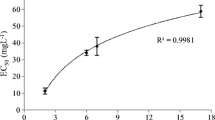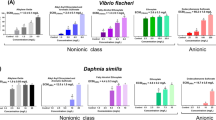Abstract
The purpose of this study was to discuss the effect of the chemical structure of anionic and non-ionic surfactants and surface activity on toxicity. Single and binary mixtures of three ether carboxylic derivative surfactants and three amine-oxide-based non-ionic surfactants were used. Toxicity was determined using three test organisms: freshwater crustaceans (Daphnia magna), luminescent bacteria (Vibrio fischeri), and microalgae (Selenastrum capricornutum). The toxicity of surfactants is related to the hydrophobic alkyl chain, the degree of ethoxylation, and the critical micelle concentration of surfactants. Relationships found agreed with the fact that the lower toxicity is shown by the shorter alkyl chain. There is a strong relation between surface activity and toxicity: the toxicity increased as the CMC of the surfactant or mixtures of surfactants decreased. Commercial products are formulated using surfactants mixtures, so it is important to know their behavior using an easily measured property: the least toxic mixtures were formed by the surfactants having lower individual toxicity. Around the CMC, our data show a synergism for the binary mixtures. The results have given rise to a classification of the different surfactants and their mixtures according to the organism test, as safe, harmful or toxic. V. fischeri was in general the most sensitive microorganism to the toxic effect of the surfactants, followed by Daphnia magna, while Selenastrum capricornutum was more tolerant. These results can be useful for selecting technically efficient surfactants and their mixtures with a lower ecotoxicity on the aquatic environment.



Similar content being viewed by others
References
Resnik GO, Vishwanath P, Pynn MA, Sitnik JM, Todd JJ, Wu J, Jarrell KA (2010) Use of sustainable chemistry to produce an acyl amino acid surfactant. Appl Microbiol Biotechnol 85:1387–1397
CNAE (2009) Observatorio Industrial del Sector Químico. Tendencias en el uso de la Biotecnología en el Sector Químico (2009) http://www.fedit.com/Spanish/DocumentosInformes/Portal/Publico/DocumentosEInformes/ObservatoriosIndustriales/Jornadas%20Difusi%C3%B3n%202009/OI-Qu%C3%ADmico.pdf
Anastas PT, Kirchhoff MM (2002) Origins, current status, and future challenges of green chemistry. Acc Chem Res 35:686–694
Steber J, Guhl W, Steker N, Schröder FR (1995) Alkyl polyglycosides-ecological evaluation of a new generation of nonionic surfactants. Tenside Surfact Deterg 32:515–521
Ying GG (2005) Fate, behavior and effects of surfactants and their degradation products in the environment. Environ Int 32:417–431
Liwarska-Bizukocj E, Miksch K, Malachowska-Jutsz A, Kalka J (2005) Acute toxicity and genotoxicity of five selected anionic and non-ionic surfactants. Chemosphere 58:1249–1253
Yu Y, Zhao J, Bayly A (2008) Development of surfactants and builders in detergent formulations. Chinese J Chem Eng 16:517–527
Jurado E, Fernández-Serrano M, Lechuga M, Ríos F (2012) Environmental impact of ether carboxylic derivative surfactants. J Surfact Deterg 15:1–7
García MT, Campos E, Ribosa I (2007) Biodegradability and ecotoxicity of amine oxide based surfactants. Chemosphere 69:1574–1578
Merrettig-Bruns U, Jelen E (2003) Anaerobic biodegradation of detergent surfactants. Final Report. Fraunhofer Institute for Environmental, Safety and Energy Technology UMSICHT, Oberhausen
Cross J (1994) Cationic surfactants. In: Cross J, Singer J (eds) Analytical and biological evaluation, surfactant science series, vol 53. Marcel Dekker, New York, pp 140–175
Domingo A (1995) A guide to the surfactants world. Editorial Proa, Barcelona
UNE EN ISO 11348-2 (NORMA UNE EN ISO 11348-2) (2009) Water quality—determination of the inhibitory effect of water samples on the light emission of Vibrio fischeri (Luminescent bacteria test)–part 2: method using liquid-dried bacteria. Spanish Association for Standardisation and Certification, Madrid
UNE-EN ISO 6341 (NORMA UNE EN ISO 6341) (2013) Water quality—determination of the inhibition of the mobility of Daphnia magna Straus (Cladocera, Crustacea)–acute toxicity test)–acute toxicity test. Spanish Association for Standardisation and Certification, Madrid
UNE-EN ISO 8692 (NORMA UNE EN ISO 8692) (2012) Water quality—fresh water algal growth inhibition test with unicellular green algae. Spanish Association for Standardisation and Certification, Madrid
Jurado E, Fernández-Serrano M, Núñez-Olea J, Luzón G, Lechuga M (2009) Acute toxicity and relationship between metabolites and ecotoxicity during the biodegradation process of non-ionic surfactants: fatty-alcohol ethoxylates, nonylphenol polyethoxylate and alkylpolyglucosides. Water Sci Technol 59(12):2351–2358
Csherháti T, Forgács E, Oros G (2002) Biological activity and environmental impact of anionic surfactants. Environ Int 28:337–348
European Economic Community (EEC) (1967) Council Directive of 27th June 1967 on the approximation of laws, regulations and administrative provisions relating to the classification, packaging and labelling of dangerous substances (67/548/EEC)
Pettersson A, Adamsson M, Dave G (2000) Toxicity and detoxification of Swedish detergents and softener products. Chemosphere 41:1611–1620
Szwach I, Hreczvch W, Fochtman P (2002) Comparative evaluation of environmental impact of fatty alcohol ethoxylates and fatty acid methyl ester ethoxylates as nonionic surfactants. Proceedings, 5th world conference on detergents: reinventing the industry: opportunities and challenges, October, 13–17, 2002, Montreux, Switzerland, pp163–165
Uppgård L, Sjöström M, Wold S (2000) Multivariate quantitative structure-activity relationships for the aquatic toxicity of alkyl polyglucosides. Tenside Surfact Deterg 37:131–138
Hisano N, Oya M (2010) Effects of surface activity on aquatic toxicity of binary surfactant mixtures. J Oleo Sci 59(11):589–599
Hua XY, Rosen MJ (1982) Synergism in binary-mixtures of surfactants. 1 Theoretical analysis. J Colloid Interface Sci 90:212–219
Werts KM, Grady BP (2011) Mixtures of nonionic surfactants made from renewable resources with alkyl sulfates: comparison of headgroups. J Surfact Deterg 14:77–84
Kume G, Gallotti M, Nunes G (2008) Review on anionic/cationic surfactant mixtures. J Surfact Deterg 11:1–11
Zhou Q, Rosen MJ (2003) Molecular interactions of surfactants in mixed monolayers at the air/aqueous solution interface and in mixed micelles in aqueous media: the regular solution approach. Langmuir 19:4555–4562
Acknowledgments
This research was supported by the Ministry of Education of Spain (FPU Grant AP2009-2226).
Author information
Authors and Affiliations
Corresponding author
Electronic supplementary material
Below is the link to the electronic supplementary material.
About this article
Cite this article
Fernández-Serrano, M., Jurado, E., Fernández-Arteaga, A. et al. Ecotoxicological Assessment of Mixtures of Ether Carboxylic Derivative and Amine-Oxide-Based Non-ionic Surfactants on the Aquatic Environment. J Surfact Deterg 17, 1161–1168 (2014). https://doi.org/10.1007/s11743-014-1621-2
Received:
Accepted:
Published:
Issue Date:
DOI: https://doi.org/10.1007/s11743-014-1621-2




